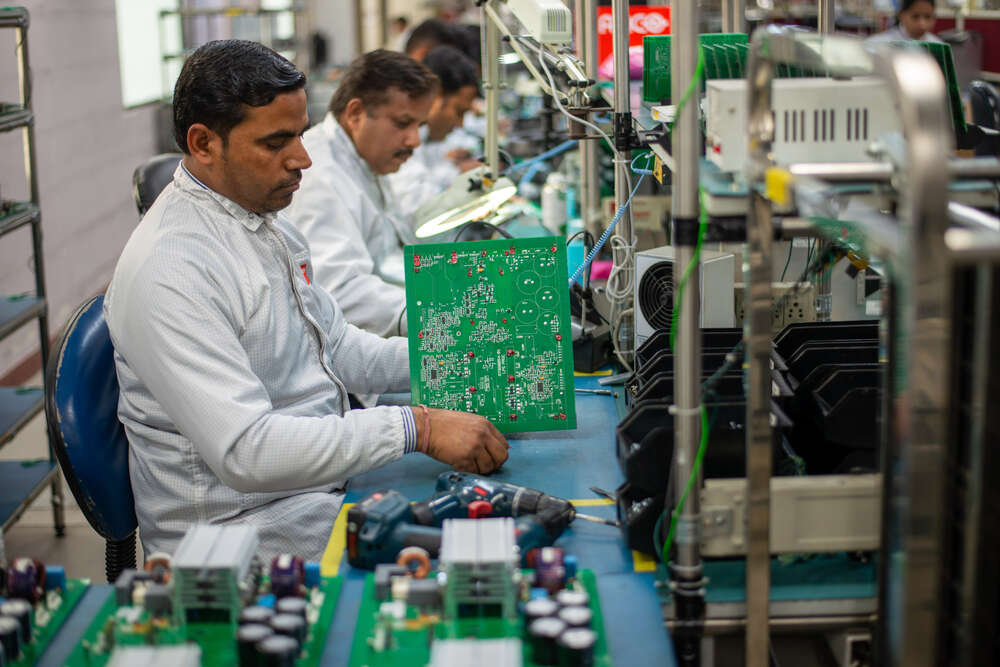
World leaders get a lot of elaborate gifts. Take, for example, the Louis Vuitton golf bag given by France’s Emmanuel Macron to Donald Trump in 2018, or the more lively Komodo dragon presented to George H.W. Bush by Indonesian President Suharto in 1990. But on 29 March, Indian prime minister Narendra Modi received an uncharacteristically tiny present. After meeting with NXP CEO Kurt Sievers in New Delhi, Modi was photographed holding a small, grey plaque emblazoned with one of the Dutch manufacturer’s semiconductors. It’s a less impressive item to hang on the wall, to be sure, than the eighteenth-century Bengali sword he was gifted by Vladimir Putin in 2015 — but certainly one more relevant, and potently symbolic, of the former chaiwala’s industrial ambitions for India.
Like many politicians around the world, Modi has come to realise that semiconductor manufacturing plays an outsize role in keeping the world economy moving. The supply chain crises that followed the pandemic not only reduced the flow of chips to electronics and auto factories to a trickle, but also inadvertently highlighted global dependence on the Taiwan Semiconductor Manufacturing Company (TSMC) as the source for these tiny but integral components. Hostage to a firm headquartered in a nation threatened with invasion every day by China, many countries began investing in their own semiconductor manufacturing capabilities.
As such, new semiconductor factories, known as fabs, are being planned across the US, EU, China and Southeast Asia. But as relations between Washington and Beijing continue to deteriorate, Modi’s India sees an opportunity not just to strengthen its hand in the global semiconductor supply chain but position itself as a hub for chip manufacturers the world over. It’s a grand ambition, and one that seems feasible for a country that already boasts considerable technological expertise, whether that’s in its famed telecoms sector or its flourishing electronics industry. But chipmaking poses a different kind of challenge — one that’s set to place immense pressures on the capabilities of the world’s largest democracy.

India’s semiconductor dreams
These are problems that, in part, India intends to solve by throwing down some cold hard cash. Last year, New Delhi announced its intention to spend some $30bn building its own semiconductor supply chain, the better to ensure that it isn’t “held hostage” to foreign providers, as diplomat Gourangalal Das put it to Nikkei Asia. That this message was conveyed by India’s de-facto ambassador to Taiwan only underscored the obstacles and opportunities the former has begun to perceive in the US-Chinese rivalry over semiconductors. In March 2023, India signed a memorandum of understanding with the US declaring both countries’ intention to build a resilient semiconductor supply chain that would reduce global dependency on Beijing and Taipei.
This isn’t India’s first attempt to build a domestic chipmaking industry, but past efforts have been dogged by bureaucratic dysfunction and political instability, which delayed vital infrastructure improvements. The country was the front-runner for a multibillion-dollar Intel chip plant back in 2007, but these plans fell through after the government dragged its heels on introducing an investment policy on semiconductors.
Could this time be different? India has enjoyed a period of relative political stability in recent years under Modi. Consequently, “the ease of doing business has improved,” says Dr Gaurav Gupta, a specialist semiconductor industry analyst at Gartner. Nevertheless, India also faces accusations of democratic backsliding from prominent NGOs like Freedom House. Under Modi’s Hindu nationalist BJP Party, says the think tank, there has been increased pressure on human rights groups, widespread intimidation of journalists, and a spate of violent attacks against Muslims. This decline in civil liberties, if it continues, might come to pose a reputational obstacle to any company seeking to invest in India in the future.
India, Vietnam and Singapore are all strong contenders for any investors looking to steer clear of any potential instability swirling around China and Taiwan, says Professor Sarah Kreps, who runs Cornell University’s Tech Policy Institute. They’re still in Asia, so can directly plug into the continent’s vast technological landscape, but they also benefit from their non-alignment with either Beijing or Washington. In this new era of confrontation between the two superpowers, it’s hard for existing chipmaking powerhouses like Japan and South Korea to continue dealing with China because, says Kreps, they’re “so clearly aligned with the United States.” India, Vietnam, and Singapore, she adds, get to “play down the middle and work with both”.
India is also home to a huge technological talent base and labour tends to be cheaper than in China or Europe which, says Kreps, holds obvious appeal for international investors. What’s more, the country has a potentially huge domestic market for any semiconductors it might manufacture, thereby reducing its exposure to volatility in the global chips market. There’s also the question of space compared to its potential future rivals: Singapore, for example, has a lot of technological know-how but the city-state’s small area doesn’t leave much room for expansion. Ultimately, says Gupta, “what India offers is scale”.

Big steps for a small chip
Whether it has the skills or the national resources necessary to build a semiconductor manufacturing industry from scratch is another question. None of that is easy to come by. Fabs require reliable water and electricity grid connections, and a highly trained workforce capable of assembling semiconductors with extreme precision using expensive equipment in ultra-clean environments. “If you get one little step wrong,” says Kreps, “the whole process implodes.”
Can India rise to these challenges? When it comes to water, the World Bank says India is ‘one of the most water-stressed nations in the world,’ but it highlights that the country has seen great success providing reliable access to certain urban areas — so manufacturers can simply direct investment towards more secure regions. Electricity might be tougher to guarantee. In April and May 2022, India’s existing electronics manufacturers were plagued by repeated power outages and coal shortages. The country has since directed record investment toward renewable energy sources, but it’s unclear how quickly these could ease pressures on its electrical grid.
Despite all this, Gupta remains optimistic. “They have other high-volume manufacturing in the country,” he says. “They can obviously work through these issues.”
Whether foreign investors have the patience is another question altogether. Setting up a new semiconductor plant is extremely capital-intensive. That’s the main reason why companies such as Intel and TSMC have backed out of previous projects — and why they might still choose to channel their investments toward places with existing chipmaking infrastructure, like Vietnam. Moreover, while India does have a large base of highly skilled engineers, Gupta says it’ll need experts with specific experience in the precise art of semiconductor fabrication. Most of these people will likely have to come in from abroad, which brings extra costs.
There have been recent reports of a joint venture between India’s Vedanta and Taiwan’s Foxconn to build a semiconductor plant in Gujarat, but Gupta warns that neither of these firms is a semiconductor specialist. That’s why he doesn’t think there’s cause for celebration just yet. Gupta says India needs a proposal from one of the big established chipmakers. If that happened, he says his “confidence level in terms of the project actually getting executed would be higher”.
But India still has room for hope. “Not everyone needs to be as good at this as Taiwan,” says Kreps, referring to TSMC’s dominance in high-end chipmaking. India could, she argues, establish itself as “a manufacturer of certain types of chips”, even if “they’re not the latest and greatest”.
It’s not just about semiconductors. Building domestic chipmaking capacity could support India’s broader ambitions of becoming a tech hub by providing reliable access to core components and attracting industry giants. Indeed, India has been building technological ties with the US beyond chipmaking and could soon become a key supplier of electronic parts and hardware, according to US Commerce Secretary Gina Raimondo. Indeed, iPhone supplier Foxconn is already shifting some of its manufacturing from China to India and recently announced plans to build a 300-acre manufacturing facility in Bengaluru.
“A reordering of the semiconductor world” is afoot, announced New Delhi’s minister of state for electronics and information technology, Rajeev Chandrasekhar, in March. But while India has a chance to win fresh chipmaking investment off the back of the crumbling relationship between the US and China, said Chandrasekhar, it shouldn’t delude itself into thinking it can be the “king of the hill” — at least, not yet.






